In the early months of the First World War, the British were faced with a dilemma. Traditionally, British strategy called for using sea power to attack the flanks of an enemy, instead of facing them head-on. The question was where they should make this attack, or if they should just double down on the force in France. Jackie Fisher, the uniformed head of the Royal Navy, had proposed an attack on the German Baltic coast, ultimately abandoned due to the risks of taking ships into such narrow waters from mines, torpedoes, and coastal fortifications. His civilian counterpart, a rising star by the name of Winston Churchill, instead favored an attack on the other side of Europe, hoping to knock the Ottoman Empire out of the war with an attack on the Turkish Straits connecting the Mediterranean and Black Seas, which would both make it easier to ship supplies to Russia and capture the Ottoman capital of Constantinople.
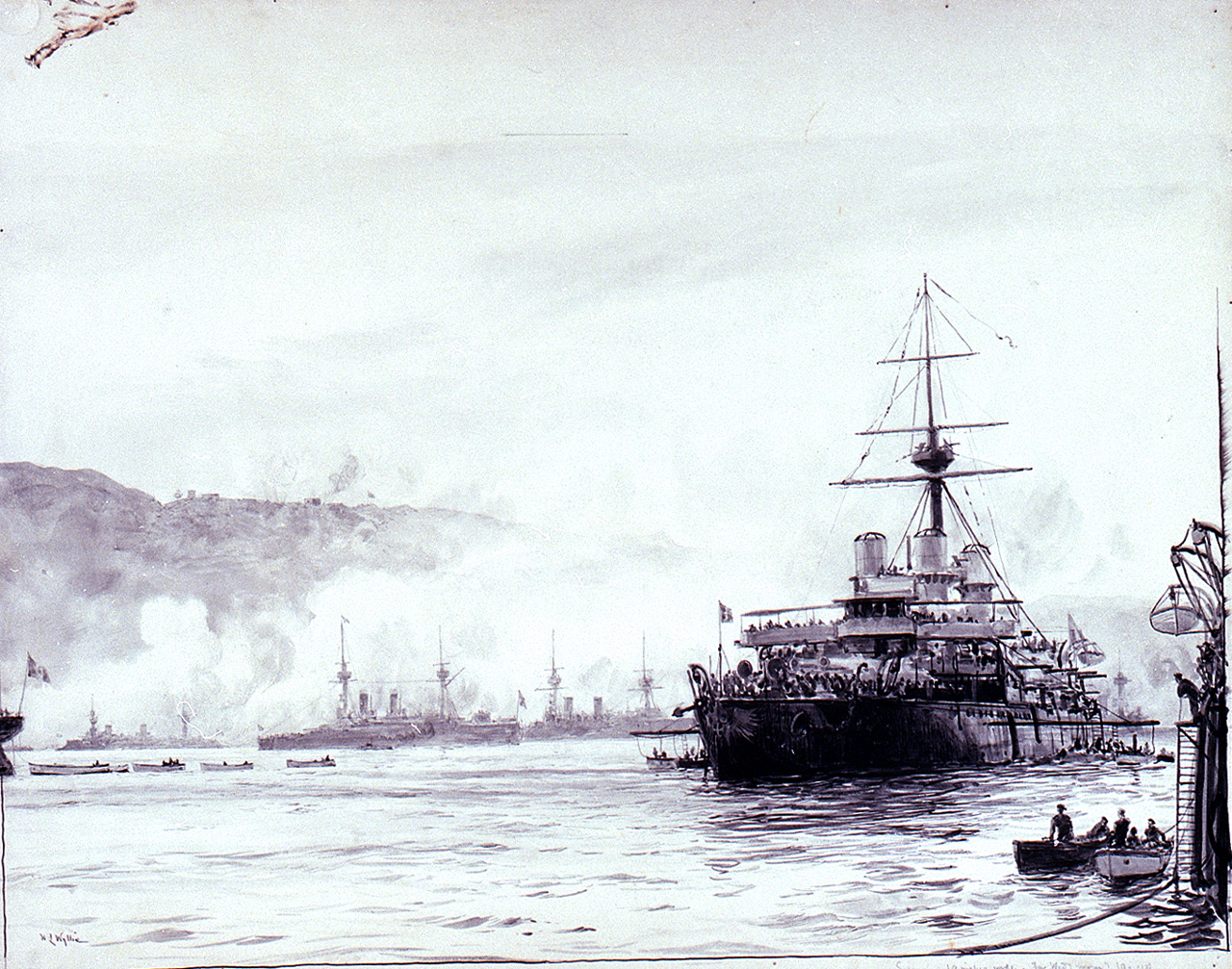
British battleships shell Turkish fortifications in the Dardanelles
Tensions with the Ottomans had begun to rise after Goeben and Breslau took refuge in Constantinople during the opening days of the war, but the Turks remained neutral until the ex-German ships, now sold to them, conducted a rogue bombardment of Russian positions in the Black Sea. The British and French retaliated on November 3rd by bombarding fortification in the Dardanelles, the westernmost of the Turkish straits, blowing up a magazine on one of the outermost forts. This performance made them overconfident in their ability to take out fortifications with naval bombardment, and after war was declared two days later, planning began in earnest for an all-naval campaign against the Dardanelles.
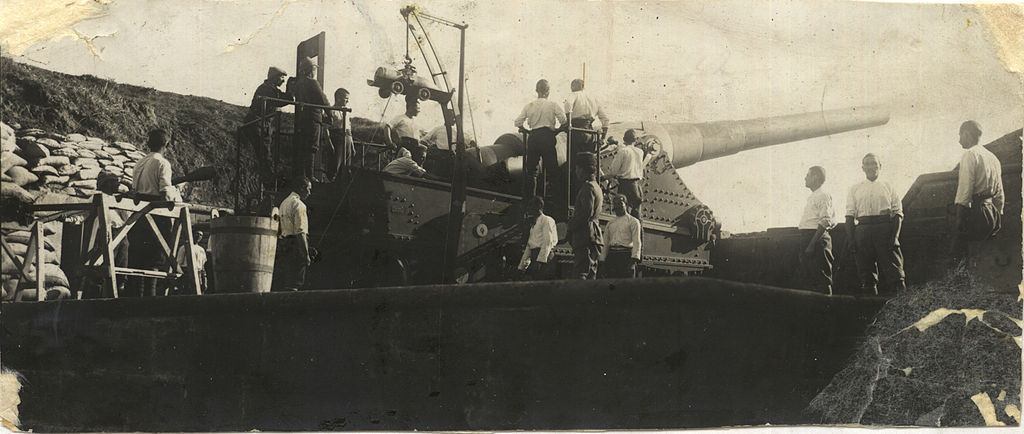
An Ottoman coastal defense gun
The Germans were well aware of the threat, and immediately sent a core of artillerymen and engineers to bolster the Turkish defenses. The defenses themselves were not in great shape, with only 14 modern guns among the 100 or more emplaced, and limited ammunition. The British and French had large numbers of obsolescent pre-dreadnoughts available for this scheme, to be backed up by a few modern ships. The idea was that these would easily be able to overwhelm the defenses from outside their range, a theory bolstered by the success of German guns against the Belgian forts in the opening weeks of the war. But things weren't so simple, as the shipboard guns didn't have the stable platforms of siege artillery, and could only elevate to 15°. Fortifications required direct hits to put them out of action, and the Allied supply of shells was too limited to achieve enough of these. The planners had also disregarded the threat of mines, and the potential use of mobile guns by the defenders.
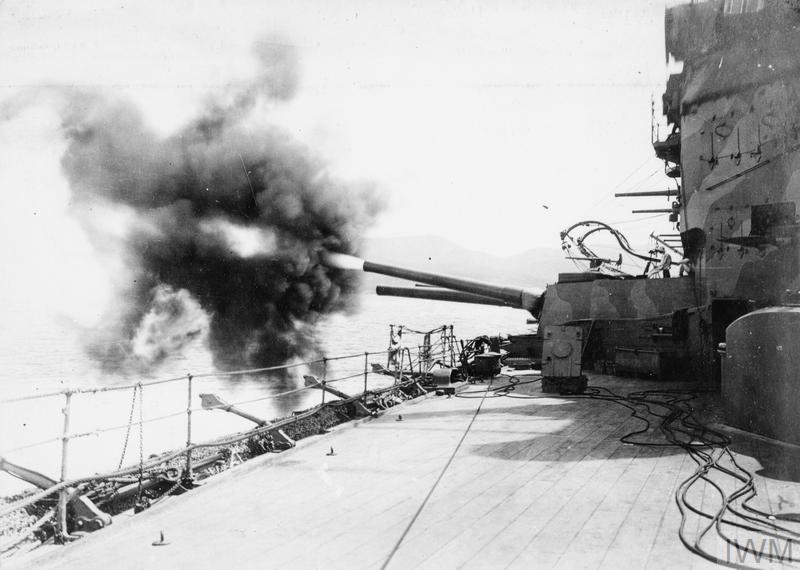
HMS Agamemnon fires at Turkish positions
The assault began in earnest in February 1915, when a pair of destroyers began to probe the Ottoman defenses, backed up by pre-dreadnoughts Cornwallis and Vengeance at long range. The results were disappointing, but the Ottomans soon evacuated the outer defenses, falling back on positions further in where they couldn't be engaged from outside the straits. Royal Marines were sent ashore to demolish the outer forts, largely successfully, but going after the inner forts would involve actually entering the Dardanelles, and exposing the fleet to mines. Civilian trawlers had been requisitioned to clear them, still manned by their original crews, but they were slow and their crews were not willing to work under fire. Occasional small attacks were made throughout the first half of March, with little success.
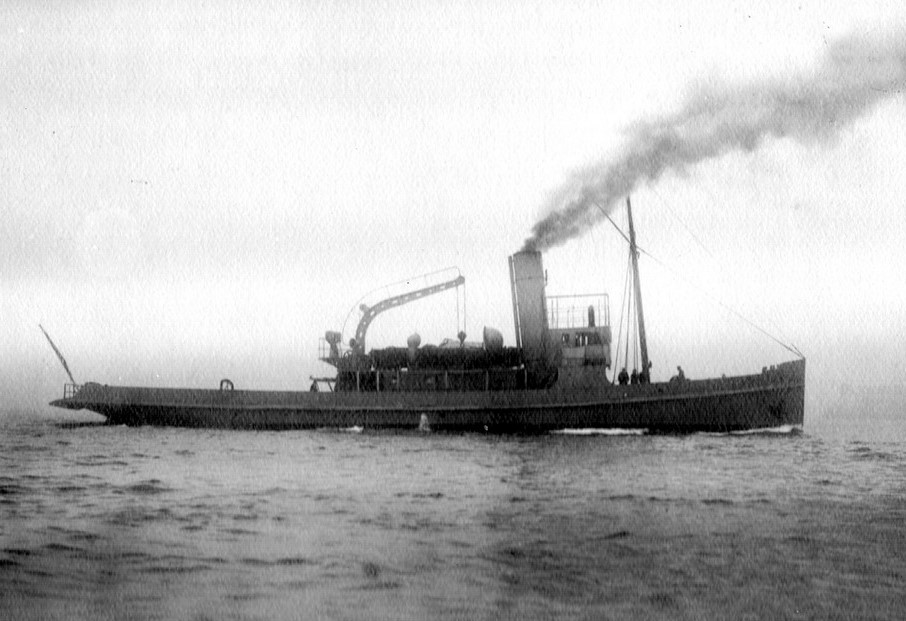
Nusret
The first major attack was planned for March 18th, with 16 British and French pre-dreadnoughts, backed up by Queen Elizabeth and Inflexible, entering the straits and attempting to silence the inner defenses before the sweepers went in that night. Unfortunately, while they were able to avoid all the minefields they knew about, the Turkish minelayer Nusret had laid 20 mines in a new area, precisely where the ships would turn around when withdrawing. The attack was reasonably successful at driving the defenders from their batteries, although the French battleships Gaulois and Suffren were badly damaged by shellfire from shore. But it was as they withdrew that one of their companions, Bouvet, struck a mine and sank in minutes. The commander believed that this was the result of a shell hit or a torpedo, and pressed the attack for another two hours, until the battlecruiser Inflexible was mined as she, too, began to withdraw. The mine inflicted severe damage to her, and she had to be beached on a small island just outside the Dardanelles to keep her from sinking. Soon after, Irresistible struck a mine, and an attempt by Ocean to tow her clear merely resulted in another casualty. Both pre-dreadnoughts had to be abandoned as the Anglo-French task force withdrew in disarray.
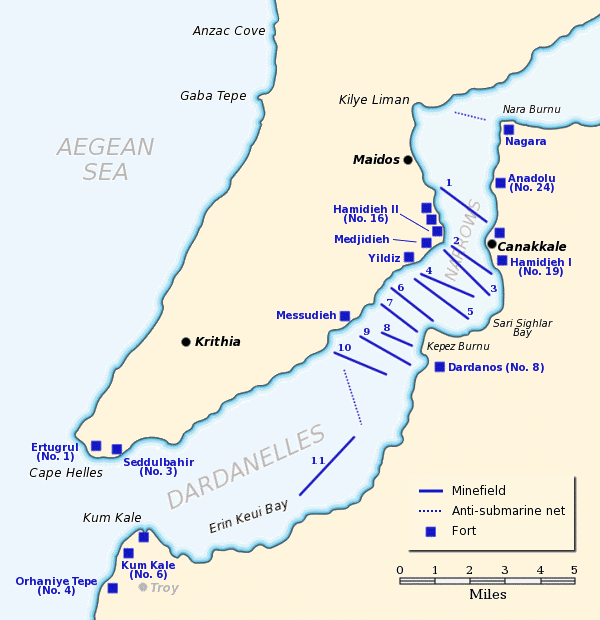
There was considerable confusion over what to do next. Churchill correctly pointed out that all of the mined ships, with the exception of Inflexible, were expendable, and pushed for a resumption of the naval attack. The crews of the mined battleships could take over the trawlers, and would be far more willing to sweep under fire. But others believed that the naval attack was inherently flawed, either because the defenses couldn't be overcome from the sea or because forcing the straits with a naval force might just leave said naval force trapped in the Sea of Marmara with no actual way to force the Ottomans out of the war. This school ultimately prevailed, and in April, troops went ashore on the Gallipoli Peninsula. Unfortunately, this was no more successful than the naval attack, with the troops, a mixture of British, French, Australian and New Zealander, trapped on the narrow ridges of Gallipoli until they were evacuated in January 1916.
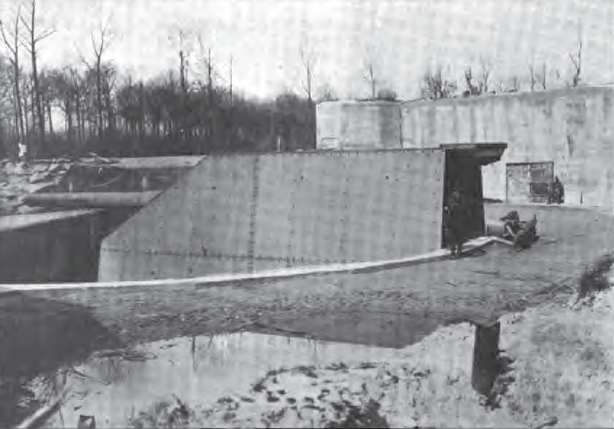
Lange Max in Belgium
The threat of amphibious assault also led to coastal defenses being built elsewhere in Europe. The Germans were particularly sensitive to the threat of amphibious assault on the captured Belgian coast, and placed its defense in the hands of Marinekorps Flandern, which was also responsible for holding the extreme right of the German line on land. Marinekorps Flandern built a number of batteries along the coast, most using either captured Belgian or British Artillery or obsolescent guns taken from the defenses along the German coast. The largest were five 38 cm guns originally intended for the Baden class battleships. One of these guns, known as Lange Max, became famous for its service not against sea targets but in firing against the Allied positions in Dunkerque, 45 km away. Its position is preserved today, although the gun itself was destroyed postwar. It was far from unique in firing against land targets, and as a result of Allied counterfire from both land-based artillery and monitors offshore, the positions were heavily reinforced with bombproof bunkers. In total, the Germans seem to have deployed 28 5.9", 8 6.7", 8 8.2", 21 11", 4 12" and 5 15" guns along the Belgian coast. They gave valuable service, with the heavy guns outranging the monitors of the Lord Clive class so effectively that these ships were considered mostly useless by 1916. One 5.9" battery still survives today, although it was incorporated into the Atlantic Wall during WWII.
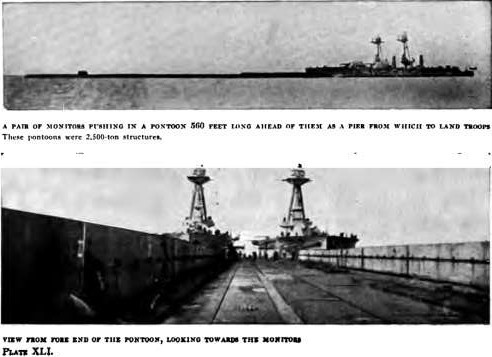
British monitors tow a pontoon
The British were concerned by the German presence on the Belgian coast, where Ostend and Zeebrugge served as bases for U-boats and coastal craft that menaced the English channel. Plans were made to eject them using an amphibious landing, coordinated with an offensive from troops around Ypres. The lessons of Gallipoli were studied, and plans were made to attach massive pontoons between pairs of monitors, three of which could carry an entire division, backed up by tanks and artillery. Unfortunately, while the amphibious operation was ready to go by mid-1917, the land offensive that it was to coordinate with turned into perhaps the bloodiest meatgrinder the world has ever seen, and the decision was made not to attempt the landing. This was slightly odd, as the risk of a division of troops and a half-dozen low-value ships was nothing compared to the slaughter happening around Ypres. The odds of it working weren't good, but in the brutal logic of the First World War the potential payoff would have been worth the cost.
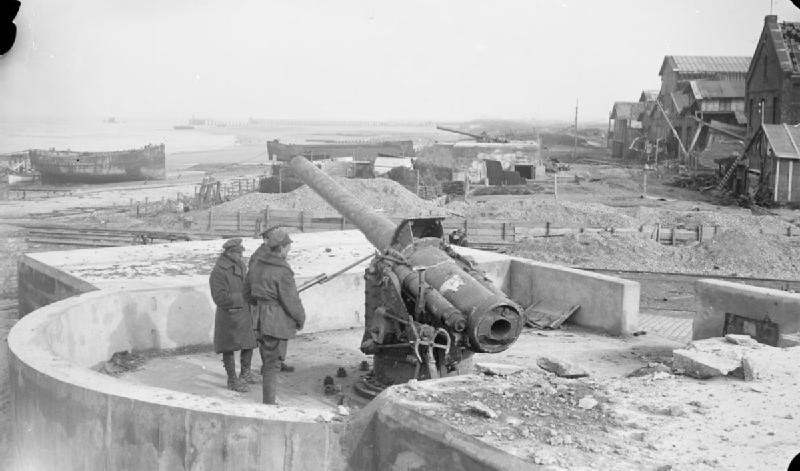
German 15cm coastal gun near Zeebrugge
The British did attempt a more limited amphibious operation in April 1918, when they attempted to block the canal from Bruges, where many of the German submarines and torpedo boats were based, to Zeebrugge, where they actually entered the Channel. The plan was to land troops from the old cruiser Vindictive and a pair of ferries on the mole1 and then, with the battery on the mole out of action and the Germans distracted, sail three obsolete protected cruisers to the mouth of the canal, where they would be scuttled. A second raid on Ostend would cut Bruges off from the sea, removing the base for the Flanders submarines which accounted for 25% of British shipping losses.
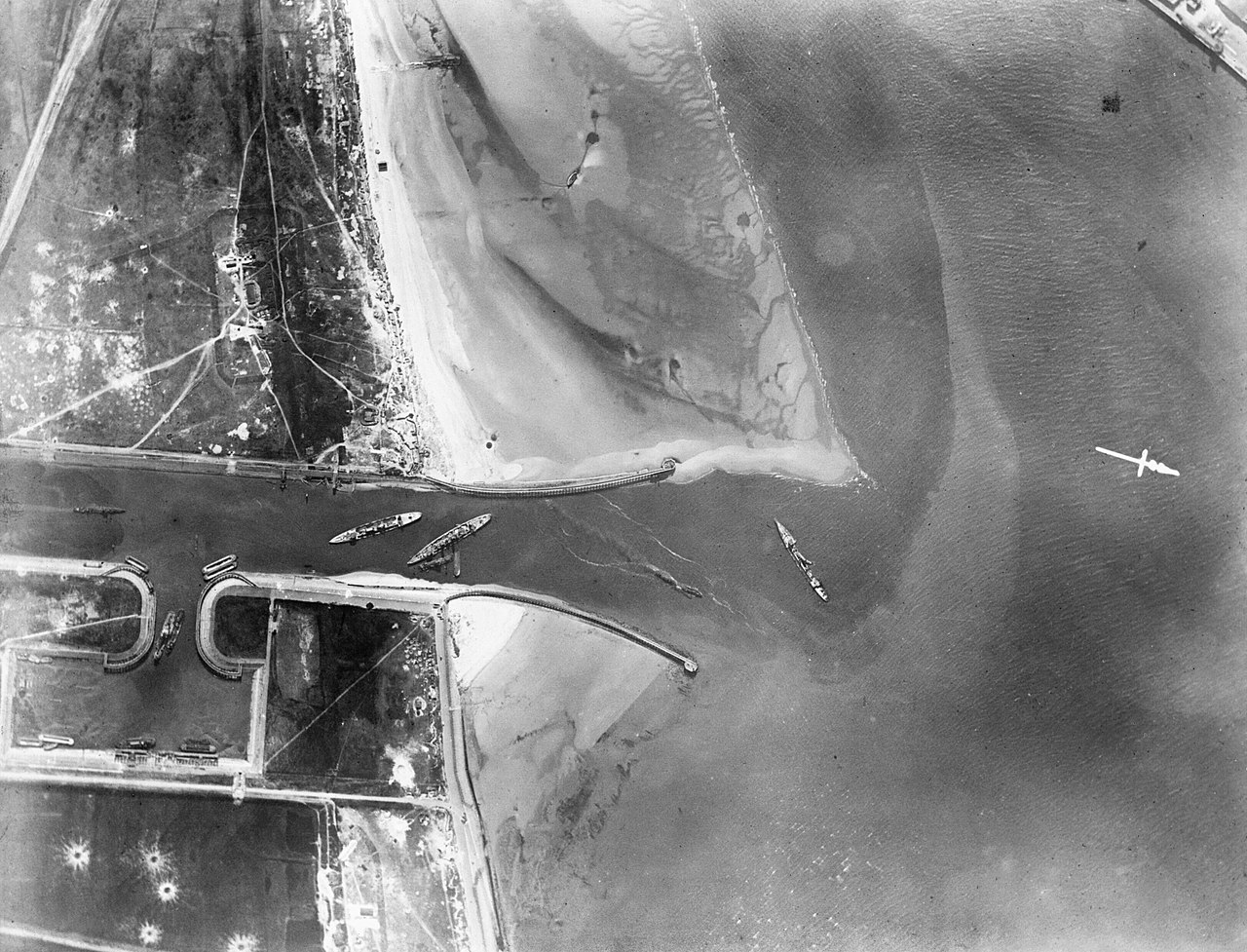
An aerial photograph after the Zebrugge Raid
Unfortunately for the British, the plan fell apart when a shift in the wind whipped away the smoke screen that was protecting the attacking force from German defenses, and Vindictive landed in the wrong place, denying the landing party her covering fire. With the mole battery still active, one of the blockships failed to reach the canal entirely, and while the other two were scuttled in approximately the right place, they weren't able to actually block the canal, and U-boats were passing around them within a couple of days. The parallel attack on Ostend completely failed when both blockships ran aground early, and a second raid in May was also thwarted by German defensive gunfire, with Vindictive herself being sunk only partially blocking the channel. Further operations were rendered unnecessary by the success of the convoy system in countering the U-boats and the Allied recapture of Flanders in the closing weeks of the war.
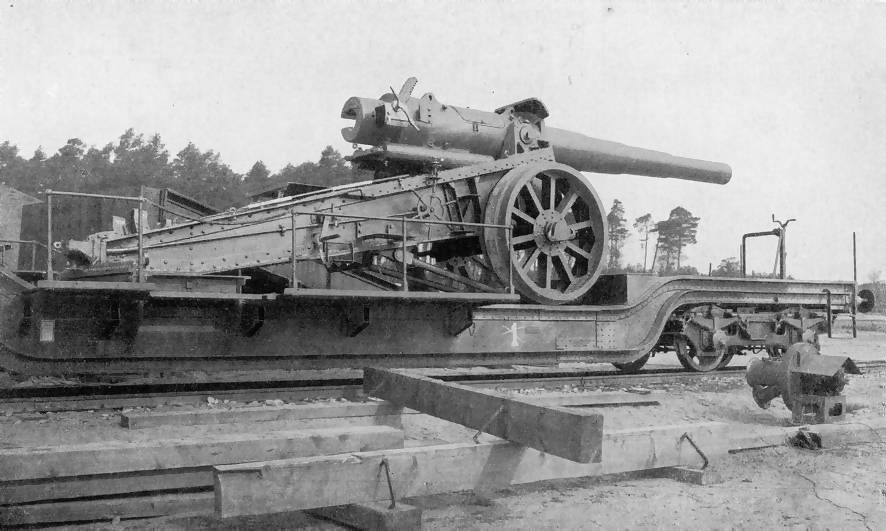
A 17cm railway gun
The last year of the war also saw the Germans introduce additional mobile guns to the defenses of Belgium, mounting both 17 cm and 28 cm guns on railway carriages to provide a mobile backup to the fixed defenses. But this idea was hardly unique to Germany, and we'll take a look at its worldwide use next time.
1 The term for a large sea wall that protected the harbor from the waves of the open sea. ⇑

Comments
Reading Corbett, this seems inaccurate. British strategy called for fighting the enemy where British sea power would provide tactical and operational advantages to the British forces. Which has less to do with flanks, and more with terrain and logistics. By this logic, it's pointless to storm the German coast, where the Germans have an extremely easy time rushing troops and supplying them. What you'd want to do is something like Wellington's peninsular campaign - fight in a remote location where you can move and supply freely by ship.
Yes, there's more to it than that, but this isn't a summary of British strategic thinking, and I just needed to set up the very rough logic behind Gallipoli. As for the Baltic strategy itself, there were a lot of skeptics, and they ultimately carried the day on the matter.
This is a little tangential, but coastal defense often seems to end up with the dregs of whatever the regular army didn't want, except when it gets some huge investment.
So what do you do when your assorted artillery uses a dozen obscure ammunition types, some of which was found in a barn?
Do you just give the crews what you've got and say "look, sorry, we couldn't find the manual, but I'm sure you'll notice if these turn out to be training rounds?"
Is it just one of those things that make situations like the turks' so difficult?
Costal artillery does have a number of advantages to make up for obsolecent weapons. You get a stable firing platform, earth/masonry walls, the ability to better disperse your assets, better survivablility (you're not going to sink if your walls get breached), up to a hundred metres of height advantage (geography permitting) and the crew has the ability to run away if things go wrong.
Look at what happened in Drøbak Sound.
This might actually be one situation where reserve forces have the advantage over regulars. Since they are more likely than active duty forces to be assigned to the same post for long periods of time, they have the opportunity to understand the quirks of their particular weapon. (My opinion here is mostly colored by Kommandørkaptein Anderssen at the battle of Drøbak Sound, who had been retired for 13 years when called out to command a battery of 40-year old torpedoes and subsequently used them to sink a German heavy cruiser.)
Quadruple post, great job me. Sorry about that bean.
One other advantage land-based forts can have against ships is MUCH better rangefinders -- they have baselines from different stations much farther apart than any two points on a ship. (I admit not knowing if the Turks had this kind of advantage or if all rangefinding was local to the fort.)
I am with bean in being skeptical of very long baseline triangulation. One thing I think I have heard of many times is known range buoys in the field of fire.
@echo
Artillery ammo is usually pretty easy to make, and all sorts of weird calibers are still available today, at least in small batches. Plus, most nations use standard shell calibers which are at least somewhat interchangeable, IIRC, so using captured old 6" guns isn't a big deal.
echo:
Probably pretty common for what are perceived to be rear area defenses since the good stuff goes to the units that are guaranteed to be in the front lines.